 Return To Home Page
Return To Home Page
 Table of Contents Page
Table of Contents Page Return To Home Page Return To Home Page
|
Back to the  Table of Contents Page Table of Contents Page |
Contents of This Page |
LUTES deserve a huge amount of space, because they were so important! This picture  links to a bigger picture of my Oud & my Saz. links to a bigger picture of my Oud & my Saz.While these are quite pretty and I need to write more about them, I'm really hoping to get a link to a grippingly exciting page on the web about Lutes by somebody who knows more about them then I do! When I do, it'll be up here! Meawhile, any offers of good addresses would be welcomed. |
|
 LUTES LUTES
| ||
 CITTERN CITTERN
| ||
 HURDY GURDIES HURDY GURDIES
|
||
 KEY FIDDLE - WHAT?? KEY FIDDLE - WHAT??
|
||
 TO The FIRST STRINGS PAGE TO The FIRST STRINGS PAGE
|
 Return to top of this page.
Return to top of this page. here are more Cittern Pictures.
here are more Cittern Pictures.
 Return to top of this page.
Return to top of this page.| Hurdy Gurdies are weird, wonderful, and deserve several whole sites to themselves. | ||
 See larger Hurdy Gurdy pictures See larger Hurdy Gurdy pictures
|
... which will be slower to download. | |

|

|

|

|
A picture of the wheel close up, showing how the strings go over it. As the wheel is turned by the handle at the end of the instrument, it rubs against the strings, like a violin bow does, and makes them vibrate and sound. You can also see that the strings have fibres wrapped round them. This is to hold the rosin: the same stuff normal string players put on their bows, it comes from the gum from certain trees; the wrapping also helps to stop the wheel & strings wearing each other out. |
|
|
Here you can see the inside of the box over the keyboard, with the flap lifted. You can see the strings passing over rows of small wooden pointed bits, which touch the strings when you press the keys up. This changes the note. It's like pressing the strings onto a guitar neck, except that here the frets lift up against the strings. The pointed bits are called tangents. You can also see that A.J. Butterworth, who made mine, has given me the modern cheat of having screws to help adjust the tangents. Most people don't get to see them...! I'm most grateful to John Heywood, of Northampton Camera Club, for these two lovely clear images of the inside of the hurdy gurdy. |
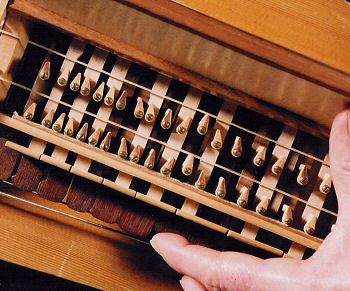
|
|
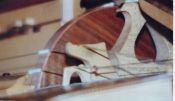
|
This view of the wheel also shows a pale bit of wood rather like a bridge in shape, near the bottom of the picture. This is the "chien" - french for "dog." It's called this because when you turn the wheel faster it vibrates against the instrument's belly, or table, and makes a buzzing noise. If you had a strong imagination you could say it's barking! It's used as the rhythm section of the instrument. Some people love it, some hate it - but everyone reacts in some way! | |
 "http://www.hurdygurdy.farmcom.net/"
"http://www.hurdygurdy.farmcom.net/"
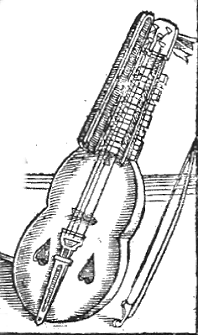
|
Praetoriusí Syntagma Musicum of the early 1600ís shows this Key Fiddle, as an extant instrument. Itís a curious cross between a hurdy gurdy and a fiddle. There's also this carving, dated around 1350, from the church at Kallunge in Germany. Then there's an existing instrument, from the Swedish town of Mora. While it has a date from the 1500's inside, scholars really can't agree when it was made. Perhaps the wood was recycled from an earlier instrument, perhaps it was repaired then and was actually older, perhaps it's a forgery, perhaps even copied from the Praetorius engraving... | |
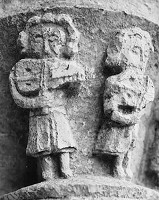
|
...whichever way it is, there are these sources. So here's a modern copy, this one made by Jean-Claude Condi of Northern France, and now ours, as of February 2004. | |
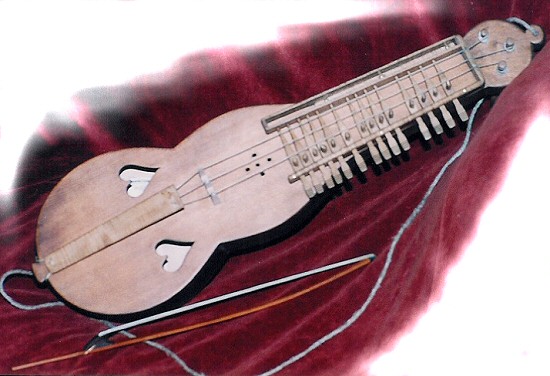
|
||
|
As you can see, there's a bow, thought very short. This is a good thing, because you play the instrument as shown in the carvings, wearing it in guitar position. So the bow goes straight up and down. This means it's aimed fairly at your nose. Any longer, and that bow goes up the nostril, which would cause a rhythmic scream each time you completed an up-stroke. Not good. The short bow and strange angle does make for quite a difficult bowing action. Since it has keys very like a hurdy gurdy, people like us who can't play fiddles can at least get a bowed sound! One string is worked by the keys. The other two act as drones, which you can choose to play or not, depending on the angle of the bow. Later, this instrument developed into the Swedish Nyckelharpa. I hope to get a link up to the Nyckelharpa society page soon, so you can see more. A PLEA FOR INFORMATION... We don't know anyone else with a keyfiddle/moraharpa (as opposed to a nyckelharpa) in Britain at present. IF you are a player, please let us know, we'd be interested to exchange notes, and perhaps learn more. |
||
 Return to top of this page.
Return to top of this page.
 Return To Home Page Return To Home Page
|
 Return to top of this page. Return to top of this page.
|